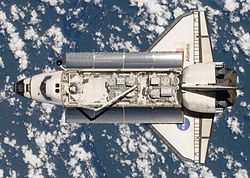ExPRESS Logistics Carrier

ELCs 1 & 2 in the Space Shuttle Atlantis cargo bay.
|
|
| Station statistics | |
|---|---|
| Part of: | International Space Station |
| Launch date: | 11 UTC |
| Launch vehicle: | Space Shuttle/STS-129 |
| Berthed: | 11 at P3 truss |
| Mass: | 13,840 lb (6,280 kg) |

ELCs 1 & 2 in the Space Shuttle Atlantis cargo bay.
|
|
| Station statistics | |
|---|---|
| Part of: | International Space Station |
| Launch date: | 11 UTC |
| Launch vehicle: | Space Shuttle/STS-129 |
| Berthed: | 11 at S3 truss |
| Mass: | 13,400 lb (6,100 kg) |
| Station statistics | |
|---|---|
| Part of: | International Space Station |
| Launch date: | 05 UTC |
| Launch vehicle: | Space Shuttle/STS-134 |
| Berthed: | 05 at S3 truss |
| Mass: | 14,023 lb (6,361 kg) |

In the Space Station Processing Facility at NASA's Kennedy Space Center in Florida, technicians perform the ELC-4, deck-to-keel mate.
|
|
| Station statistics | |
|---|---|
| Part of: | International Space Station |
| Launch date: | 02 UTC |
| Launch vehicle: | Space Shuttle/STS-133 |
| Berthed: | 02 at S3 truss |
| Mass: | 8,235 lb (3,735 kg) |
An ExPRESS logistics carrier (ELC) is an unpressurized attached payload platform for the International Space Station (ISS) that provides mechanical mounting surfaces, electrical power, and command and data handling services for Orbital Replacement Units (ORUs) as well as science experiments on the ISS. ("ExPRESS" stands for Expedite the Processing of Experiments to the Space Station.) The ELCs were developed primarily at the Goddard Space Flight Center in Greenbelt, Maryland, with support from JSC, KSC, and MSFC. ELC was formerly called "Express Pallet" and is the unpressurized counterpart to the pressurized ExPRESS Rack. An ELC provides scientists with a platform and infrastructure to deploy experiments in the vacuum of space without requiring a separate dedicated Earth-orbiting satellite.
ELCs interface directly with the ISS integrated truss common attach system (CAS). The P3 Truss has two such attach points called Unpressurised Cargo Carrier Attachment System (UCCAS) mechanisms, one facing zenith (space facing) called UCCAS-1, the other facing nadir (earth facing) called UCCAS-2. Whereas the S3 Truss has four similar locations called Payload Attachment System (PAS) mechanisms, two facing Zenith (PAS-1 and PAS-2), and two facing Nadir (PAS-3 and PAS-4).
The ELC is an un-pressurized attached payload project for the International Space Station (ISS) that provides mechanical mounting surfaces, electrical power, and command and data handling services for science experiments on the ISS. ("ExPRESS" stands for “expedite the processing of experiments to the Space Station”.) The ELCs have a deck size of about 14 feet by 16 feet and spans the width of the space shuttle’s payload bay. Each one is capable of providing scientists with a platform and infrastructure to deploy experiments in the vacuum of space without requiring a separate dedicated Earth-orbiting satellite. Each carrier is capable of carrying 9,800 lbs. to orbit and will also serve as parking fixtures for spare ISS hardware which can be retrieved when needed.
...
Wikipedia
